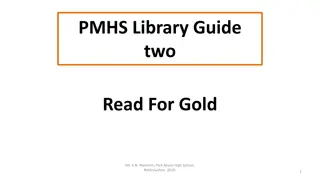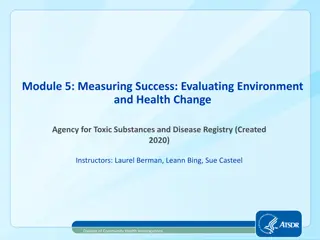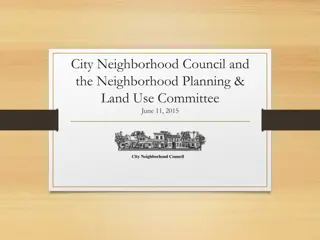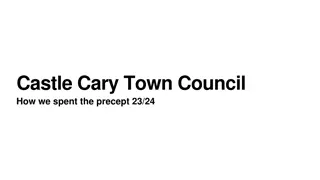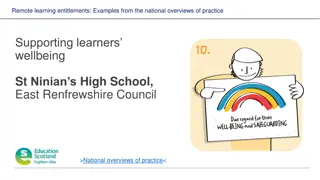Effective Tracking for Measuring Impact at Renfrewshire Council
Highlighting the implementation of tracking systems to monitor progress and trends, linking pupil data for better analysis and decision-making. The presentation showcases templates, trackers, and summaries used to evaluate performance and address attainment challenges within schools.
Download Presentation

Please find below an Image/Link to download the presentation.
The content on the website is provided AS IS for your information and personal use only. It may not be sold, licensed, or shared on other websites without obtaining consent from the author.If you encounter any issues during the download, it is possible that the publisher has removed the file from their server.
You are allowed to download the files provided on this website for personal or commercial use, subject to the condition that they are used lawfully. All files are the property of their respective owners.
The content on the website is provided AS IS for your information and personal use only. It may not be sold, licensed, or shared on other websites without obtaining consent from the author.
E N D
Presentation Transcript
Measuring Impact Through Effective Tracking Renfrewshire Council
Introduction Susan Dalrymple Head Teacher, Wallace Primary School Emma Mavers Head Teacher, Barsail Primary School Fiona Wright Management Information Officer, Renfrewshire Council Attainment Challenge Iain Shearer Active Schools and Community Club Development Officer Lead, Renfrewshire Leisure
Tracking and Monitoring Aim to have all tracking systems meeting key criteria Pupil level information Different types of data are linked Long term progression & trends can be identified Summary data is easy to access Information can be added/ removed as required Focus on ease of use so time can be spent on analysis- not on calculations Each school involved in design so that specific needs are met
Example Template Termly Tracker Long Term Tracker Data entry tabs Pupil Profile Cohort Summary School Summary Attainment Gaps Pre-calculated summary tabs Additional summary data can be generated Pivot Table Please note: All data included within this presentation does not relate to individual pupils, but is based on trends within the two schools.
Termly Tracker Previous Year Data Pupil Information Term 1 Tracking Information
Long Term Tracker Attendance & Lates Pupil Curricular Areas Information
Long Term Tracker Pupil Testing Data Information GL Progress Categories -- Much Lower - 0 + ++ Much Higher Lower Higher Expected
Pupil Profile Candidate number entered to pull information
Attainment Gaps Second set of table for pupils entitled to free meals/ clothing grants SIMD grouping can be adapted to fit school
Identifying Interventions & Measurement: Literacy Intervention PEF Teacher to support pupils in reading (0.4) Aim To improve reading skills of pupils that are behind the expected level for their stage Pupils selected from each stage based on level in reading (-1 or -2) n=17 Pupils identified using PEF referral system. 1. Pupils have increased point on progress scale (end of year) Target Group Success Criteria 2. Pupils able to meet set criteria relating to reading skills (termly) Example Criteria -To know 70-80%+ of vowel digraphs and to demonstrate awareness of alternative vowel digraphs covered -Blending and segmenting 5 sound words with vowel digraphs -Common words/tricky words for Phase 5 -To name/describe 4+ decoding strategies % of target pupils 2 years or more behind in reading (-2) % of target pupils 1 year or more behind in reading (-1) Data available for individual pupils tracked against specific criteria Example Baseline Data
Identifying Interventions & Measurement: Literacy PEF Referral System To identify individuals to target Termly tracker Level assigned for each pupil for each term in reading Teacher comments and assessment of impact available on individual progress PEF Funded Teacher Baseline Assessments Recording individual progress on specific criteria relating to reading skills
Identifying Interventions & Measurement Wellbeing Intervention Soft Start Programme Aim To reduce late coming and improve attendance. Target Group Pupils who were late on more than 10 occasions in 2016 2017. Pupils with less than 80% attendance in 2016 2017. Indicators of poverty used to prioritise. 1. Pupils that have attended programme have reduced number of late comings compared with previous year. 2. Attendance rate has improved for pupils that have attended programme Success Criteria Example Baseline Data Average late comings for target group Under 90% attendance rate for target group Individual pupil/ family data- number of lates & attendance rate
Identifying Interventions & Measurement Wellbeing Information Recorded Pupil Attendance at Soft Start Number of late comings for target pupils (monthly) Attendance rate of target pupils (monthly)
Identifying Interventions & Measurement Wider Achievement Intervention Active Schools Aim To increase the number of hours of physical activity per week Maximise number of pupils involved in extra-curricular activities Target Group Pupils who were identified through parent/ pupil survey and interviews Success Criteria 1. Pupils attend extra-curricular activities (school sport) 2. Pupils attend local approved HUB clubs (club sport) Baseline Data % rate of pupils identified as red on the activity scale (active for less than 3 hours a week)
Identifying Interventions & Measurement Wider Achievement Tracking progress Data is gathered through parent and pupil survey The survey allows information on Hours of activity per week What opportunities are being accessed extra- curricular (Schools and Active Schools) What opportunities are being accessed in the wider community (Active Schools and HUB Clubs) Pupil suggestions to create personalisation for active schools programme. Swimmer and Non Swimmer information Data gathering on SEEMiS Available as a pivot table. Can filter using poverty indicators.
Identifying Interventions & Measurement Wider Achievement Tracking progress
Assessing Impact of Intervention Key questions Has there been improvement? Has success criteria been met? Do all sources of information tell the same story? To what extent do I know that these actions are responsible for the change? How can I use this information going forward?
Assessing Impact of Intervention Literacy Success Criteria 1. Pupils have increased point on progress scale (end of year) 2. Pupils able to meet set criteria relating to reading skills (termly) Example Pupil Data Example Summary Data Level Assigned in Reading Term 1 76% N/A 63% 53% 85% Term 2 100% 81% 96% 96% 97% Baseline Follow- up Vowel Digraphs Alternate Phonemes Blending Segmenting Tricky words (1st 100) 2 years behind 1 year behind On track 80% 20% - 10% 80% 10% Holborn Reading Test 9yrs 3mths 9yrs 9mths
Assessing Impact of Intervention Wellbeing Success Criteria 1. Reduced late comings of target pupils/ families 2. Improved attendance of target pupils/families Target Group % of pupils with improved attendance rate 67% % of pupils with reduction in late comings 81%
Assessing Impact of Intervention Wider Achievement Success Criteria Target Group % of pupils with improved physical activity rate % of pupils engaged in school sport % % % of pupils progressing to club sport % % of pupils increased that are classed as swimmers %
Conclusions How effective tracking can help to measure impact Data is available in one document Minimal time is spent summarising and calculating Having data linked helps to give a better understanding of all the factors involved Trend data allows us to get a better picture of strengths/weaknesses Long term progression can help to see short and long term impacts of interventions Positive partnerships can support process of gathering and analysing information



